Content for TS 24.501 Word version: 18.7.0
1…
3…
4…
4.4…
4.4.3…
4.5…
4.5.3…
4.6…
4.7…
4.9…
4.15…
5…
5.2…
5.3…
5.3.2…
5.3.7…
5.3.19…
5.4…
5.4.1.3…
5.4.2…
5.4.4…
5.4.5…
5.4.6…
5.5…
5.5.1.2.4
5.5.1.2.5…
5.5.1.3…
5.5.1.3.4
5.5.1.3.5…
5.5.2…
5.6…
5.6.2…
6…
6.1.4…
6.2…
6.3…
6.3.2…
6.3.3…
6.4…
6.4.1.4…
6.4.2…
6.5…
7…
8…
8.2.9…
8.3…
9…
9.11.2…
9.11.2.10…
9.11.3…
9.11.3.4…
9.11.3.8…
9.11.3.14…
9.11.3.18C…
9.11.3.29…
9.11.3.33…
9.11.3.39…
9.11.3.45…
9.11.3.50…
9.11.3.53A…
9.11.3.68…
9.11.3.75…
9.11.4…
9.11.4.10…
9.11.4.13…
9.11.4.16…
9.11.4.30…
9.12
10…
A…
B…
C…
D…
D.6…
D.6.3…
D.6.8
D.7…
9.11.3.14 Authentication failure parameter
9.11.3.15 Authentication parameter AUTN
9.11.3.16 Authentication parameter RAND
9.11.3.17 Authentication response parameter
9.11.3.18 Configuration update indication
9.11.3.18A CAG information list
9.11.3.18B CIoT small data container
...
...
9.11.3.14 Authentication failure parameter p. 890
9.11.3.15 Authentication parameter AUTN p. 890
9.11.3.16 Authentication parameter RAND p. 890
9.11.3.17 Authentication response parameter p. 890
9.11.3.18 Configuration update indication p. 890
The purpose of the Configuration update indication information element is to indicate the additional information associated with the generic UE configuration update procedure.
The Configuration update indication information element is coded as shown in Figure 9.11.3.18.1 and Table 9.11.3.18.1.
The Configuration update indication is a type 1 information element.

| Acknowledgement (ACK) (octet 1, bit 1) | |
| 0 | acknowledgement not requested |
| 1 | acknowledgement requested |
| Registration requested (RED) (octet 1, bit 2) | |
| 0 | registration not requested |
| 1 | registration requested |
| Bits 3 and 4 are spare and shall be coded as zero. | |
9.11.3.18A CAG information list |R16| p. 890
The purpose of the CAG information list information element is to provide "CAG information list" or to delete the "CAG information list" at the UE.
The CAG information list information element is coded as shown in Figure 9.11.3.18A.1 and Figure 9.11.3.18A.2 and Table 9.11.3.18A.1.
The CAG information list is a type 6 information element, with a minimum length of 3 octets.
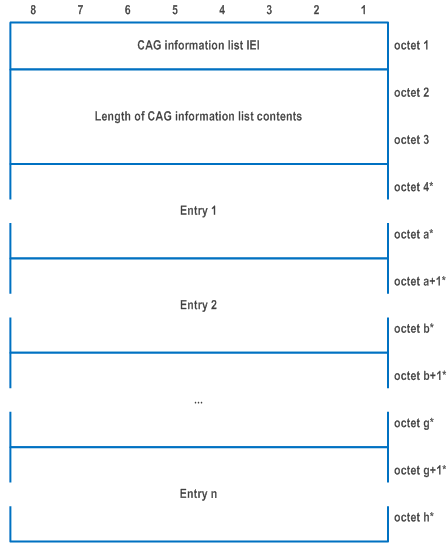
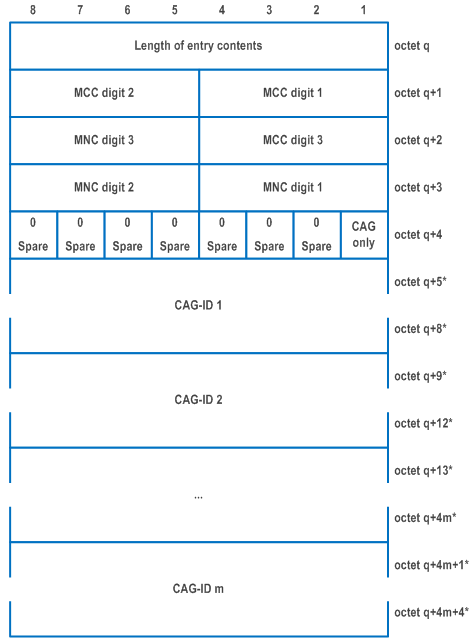
| MCC, Mobile country code (octet q+1 and bits 1 to 4 octet q+2) | |
| The MCC field is coded as in ITU-T Recommendation E.212 [42], Annex A. | |
| MNC, Mobile network code (bits 5 to 8 of octet q+2 and octet q+3) | |
| The coding of this field is the responsibility of each administration, but BCD coding shall be used. The MNC shall consist of 2 or 3 digits. If a network operator decides to use only two digits in the MNC, bits 5 to 8 of octet q+2 shall be coded as "1111". The MCC and MNC digits are coded as octets 6 to 8 of the Temporary mobile group identity IE in Figure 10.5.154 of TS 24.008. | |
| Indication that the UE is only allowed to access 5GS via CAG cells (CAGonly) (bit 1 of octet q+4) | |
| 0 | "Indication that the UE is only allowed to access 5GS via CAG cells" is not set (i.e., the UE is allowed to access 5GS via non-CAG cells) |
| 1 | "Indication that the UE is only allowed to access 5GS via CAG cells" is set (i.e., the UE is not allowed to access 5GS via non-CAG cells) |
| CAG-ID m (octet q+4m+1 to octet q+4m+4) | |
| This field contains the 32 bit CAG-ID. The coding of the CAG-ID is defined as the CAG-Identifier in TS 23.003. | |
|
NOTE 1:
The Length of CAG information list contents shall be 0 if no subscription data for CAG information list exists.
NOTE 2:
The Length of entry contents shall be 4 if there is no allowed CAG-ID for the PLMN.
NOTE 3:
Bit 2 in octet q+4 may be set to 1 in the USIM (see TS 31.102).
NOTE 4:
For a given PLMN ID, there shall be up to one Entry containing the MCC value and the MNC value of the PLMN ID.
|
|
9.11.3.18B CIoT small data container |R16| p. 892
This information element is used to encapsulate the CIoT user data, SMS, or location services message with a size that is not more than 254 octets between the UE and the AMF when the UE is using control plane CIoT 5GS optimization. The CIoT small data container information element is coded as shown in Figure 9.11.3.18B.1, Figure 9.11.3.18B.2, Figure 9.11.3.18B.3, Figure 9.11.3.18B.4 and Table 9.11.3.18B.1.
The CIoT small data container is a type 4 information element with a minimum length of 4 octets and a maximum length of 257 octets.
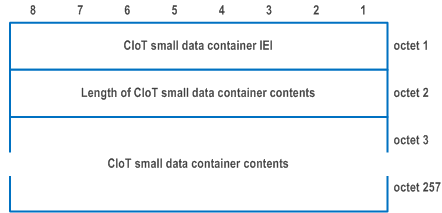
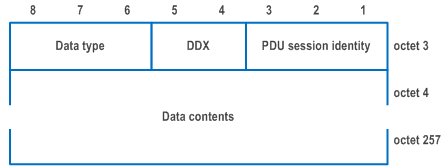
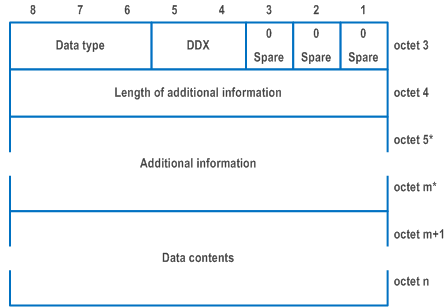
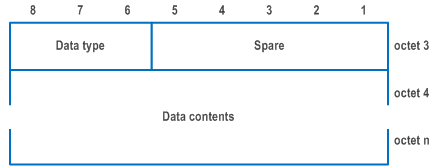
| CIoT small data container contents (octet 3 to octet 257) | |
| These octets include user data to be delivered between UE and AMF. | |
| Data type (octet 3, bits 6 to 8) | |
| Bits
8 7 6 | |
| 0 0 0 | Control plane user data |
| 0 0 1 | SMS |
| 0 1 0 | Location services message container |
| All other values are spare. If received they shall be ignored. | |
| When the Data type is "Control plane user data", the PDU session identity and Downlink data expected (DDX) fields are encoded as follows: | |
| PDU session identity (octet 3, bits 1 to 4) | |
| Bits
3 2 1 | |
| 0 0 0 | No PDU session identity assigned |
| 0 0 1 | PDU session identity value 1 |
| 0 1 0 | PDU session identity value 2 |
| 0 1 1 | PDU session identity value 3 |
| 1 0 0 | PDU session identity value 4 |
| 1 0 1 | PDU session identity value 5 |
| 1 1 0 | PDU session identity value 6 |
| 1 1 1 | PDU session identity value 7 |
| Downlink data expected (DDX) (octet 3, bits 5 to 6) | |
| Bits
5 4 | |
| 0 0 | No information available |
| 0 1 | No further uplink and no further downlink data transmission subsequent to the uplink data transmission is expected |
| 1 0 | Only a single downlink data transmission and no further uplink data transmission subsequent to the uplink data transmission is expected |
| 1 1 | reserved |
| Data contents (octet 4 to octet 257) | |
| This field contains the control plane user data. | |
| When the Data type is "SMS", Bits 1 to 5 of octet 3 are spare and shall be coded as zero. | |
| Data contents (octet 4 to octet 257) | |
| This field contains an SMS message. | |
| When the Data type is "Location services message container": | |
| Downlink data expected (DDX) (octet 3, bits 5 to 4) | |
| This field is encoded as described above for the case when the Data type is "Control plane user data". | |
| Bits 3 to 1 of octet 3 are spare and shall be encoded as zero. | |
| Length of Additional information (octet 4) (see NOTE) | |
| Indicates the length, in octets, of the Additional information field. | |
| Additional information (octets 5 to m) | |
| Contains additional information if provided by the upper layer location services application. | |
| Data contents (octets m+1 to n) | |
| Contains the location services message payload. | |
|
NOTE:
The Length of Additional information shall be set to zero if the upper layer location service application does not provide routing information.
|
|